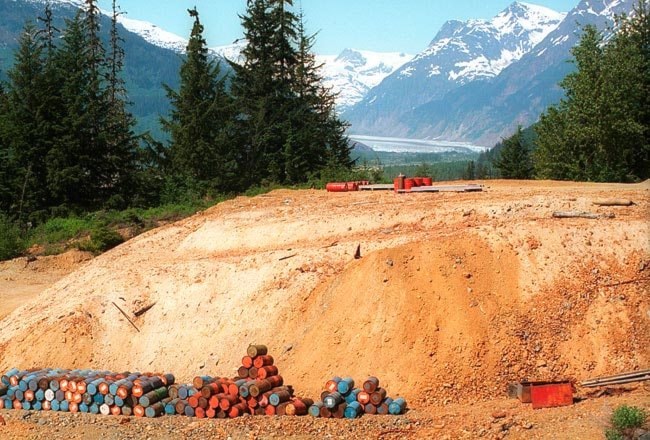In a final act as governor of Alaska, Sarah Palin asked British Columbia Premier Gordon Campbell to make sure an acid-leaking mine site on the Taku River is cleaned up after the company that owns it went bankrupt.
The BC government must ensure that a water treatment plant brought to the Tulsequah Chief mine site by Vancouver-based Redcorp Ventures Limited remains there for the possible treatment of mine tailings currently leaking sulphuric acid into the Taku, says the July 1 letter.
Redcorp went into receivership on March 27. The firm bought the 50-year-old mine site on the banks of the Tulsequah and Taku Rivers in the mid-1990s and planned to produce zinc, copper, lead, gold and silver by the summer of 2010.
The site’s original developer, Cominco, closed the mine site in 1957. Sulphuric acid from the decades-old tailings ponds has been leaking into the Taku throughout the second half of the 20th century.
“It could be characterized as a chronic problem rather than an acute one,” said Tom Crafford, the mining co-ordinator for the Alaskan department of Natural Resources’ office of project management.
The Taku River—which begins in Canada and crosses into the US north of Juneau—is home to nearly 2 million salmon who spawn there every year.
“The Taku is the largest salmon producer in Southeast Alaska,” said Crafford.
The salmon levels remain healthy despite the acid leakage, he said, but recreational and commercial fishers have been living in fear that things could change over time.
“To my knowledge, the water-quality testing that’s been conducted down at the border on the Taku River can’t really see the effects of that (acid) storage,” said Crafford.
Until Redcorp bought the site, there was no one to hold liable for the leakage.
It agreed to undertake the acid problem when it purchased the mine.
“The mining that was being done back (in the 1950s) was primarily from the valley floor upwards,” said Crafford.
Tulsequah is a series of mine shafts dotting the hills overlooking the Taku River.
“Redcorp’s plan for future mining involved going downward,” he said.
The plan involved taking the old tailings, mixing them with cement and sealing them into the ground.
Redcorp was also going to fill in some voids on the mine site to prevent leakage of less harmful tailings.
“By adding the cement and backfilling those voids, that would have effectively stopped the acid mine drainage,” said Crafford.
The solution was quickly undone after a barrage of bad news hit Redcorp, which was crippled by the crash in commodity prices last fall.
“With Redcorp’s apparent demise, there doesn’t seem to be any prospect for that happening in the near future,” said Crafford.
Not only is Alaska on Redcorp’s tail, but Environment Canada has been issuing clean-up orders to the company for a decade, said Chris Zimmer, Alaska campaign director for Rivers Without Borders.
The last order, dated May 25, demanded the acid-leak discharge be stopped because samples taken at the bottom of the mine caused “100 per cent mortality in fish in less than three hours.”
“A bankruptcy court ordered Redcorp to pay creditors and it seems like creditors are the highest priority,” said Zimmer.
“But the receiver is bound by environmental law,” he said.
There’s less certainty about what will happen if Redcorp can’t even pay off its creditors.
“How is the receiver bound by the Fisheries Act and the cleanup orders?” said Zimmer.
“Does the receiver have to make sure there’s enough money for cleanup?”
Zimmer flew by the Tulsequah mine site on Thursday.
“It’s still quite a mess,” he said.
“In the last month, most of the equipment and supplies have been removed from the site,” said Zimmer.
Zimmer wonders whether this equipment—which is ostensibly being sold to pay creditors—could be useful for clean-up purposes.
“And that water treatment plant that Redcorp claimed to have barged up there, has that been removed?” he said.
Palin’s letter also made mention of the water treatment plant—which is believed to be sitting idle and unassembled next to the mine site.
“The receiver is meant to satisfy all the claims of the creditors,” said Crafford. “And in that process, the state of Alaska wanted to do what it could to assure that none of the options for addressing the acid rock drainage issue was eliminated.
“Certainly one of the options was the installation of the water treatment plant,” he said.
“The governor wasn’t saying, ‘Install this thing and turn it on,’” said Crafford. Palin was just looking for assurance that the plant would remain on site, “because it may be the solution or the best one available in the near term.”
Toronto-based McIntosh & Morawetz Incorporated have been appointed as Redcorp’s receiver, according to a Redcorp press release.
The receiver is affiliated with the international firm Alvarez and Marsal and the person working on the file is Melanie Mackenzie, according to Troy Wilson, a former employee at Redcorp.
“I haven’t worked there for months,” said Wilson, who wouldn’t comment further.
Mackenzie did not return calls by press time.
Calls to Premier Gordon Campbell’s office were not returned either.
“By the best of my knowledge, the government and the premier’s office haven’t responded,” said Crafford, speaking from Anchorage.
A temporary solution to a decades-old acid leakage in a salmon-bearing river might be slipping away, said Zimmer.
“The question is, are we going to have the same thing we had in the 1950s, when a mining company walks away and leaves a big mess?” he said.
Contact James Munson at jamesm@yukon-news.com
